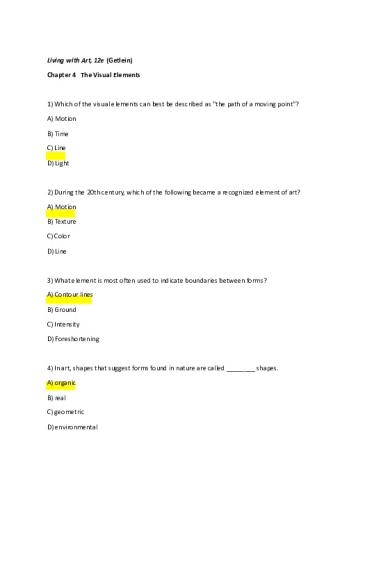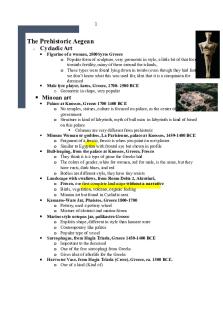Chapter 4 Assignment art PDF

| Title | Chapter 4 Assignment art |
|---|---|
| Course | Art Appreciation |
| Institution | Miami Dade College |
| Pages | 6 |
| File Size | 119.7 KB |
| File Type | |
| Total Downloads | 19 |
| Total Views | 147 |
Summary
Assignments week 1...
Description
Living with Art, 12e (Getlein) Chapter 4 The Visual Elements
1) Which of the visual elements can best be described as "the path of a moving point"? A) Motion B) Time C) Line D) Light
2) During the 20th century, which of the following became a recognized element of art? A) Motion B) Texture C) Color D) Line
3) What element is most often used to indicate boundaries between forms? A) Contour lines B) Ground C) Intensity D) Foreshortening
4) In art, shapes that suggest forms found in nature are called ________ shapes. A) organic B) real C) geometric D) environmental
5) What two basic visual cues are used to imply depth in the 18th-century Indian painting of Maharana Amar Singh and others watching musicians and acrobats? A) Chiaroscuro and hatching B) Atmospheric perspective and foreshortening C) Implied line and a vanishing point D) Position and overlap
6) A black-and-white photograph of a scene eliminates the hues and intensities of the scene's colors but captures the ________ of the colors. A) pigments B) chromas C) harmonies D) values 7) In drawing, the outer boundaries of two-dimensional forms are defined by ________, while the outer boundaries perceived among three-dimensional forms are defined by ________. A) visual elements; principles of design B) outlines; contour lines C) thick lines; thin lines D) actual lines; implied lines
8) In painting and drawing, artists often use the technique of ________ to describe the way shadows and light define the shape of forms. A) refraction B) isometric perspective C) simultaneous contrast D) chiaroscuro
9) What term describes the use of light and shadow to give a three-dimensional appearance to shapes in a two-dimensional work?
A) Pointillism B) Figure C) Ground D) Model
10) In the additive process of color mixing, red light, green light, and blue light combine to produce ________ light. A) yellow B) black C) white D) green
11) Mixing two primary colors produces a ________ color. A) secondary B) passive C) complementary D) triad
12) What term is used to describe a color lighter than a hue's normal value? A) Tint B) Shade C) Chroma D) Palette
13) In the subtractive color process, what are the secondary colors? A) Orange B) Green C) Violet D) Blue-green
E) Yellow F) Blue
14) Works that use a(n) ________ harmony feature any three colors equidistant from each other on the color wheel. A) analogous B) complementary C) triadic D) open
15) What technique uses dots of color to create a specific optical effect? A) Stippling B) Modeling C) Pointillism D) Chiaroscuro
16) What are some expressive characteristics associated with the color blue? A) Freedom B) Calm C) Passion D) Anxiety E) Quiet F) Love
17) What is a necessary feature of pattern? A) Texture B) Color C) Modeling D) Repetition
18) Where is the vanishing point in Leonardo da Vinci's The Last Supper? A) In the upper left corner of the image B) Just behind the head of the figure of Jesus C) Below the horizon line D) At the top center of the image
19) Art that moves is called ________ art. A) kinetic B) trompe l'oeil C) directional D) modeled
20) Many still-life works attempt to capture what artistic element? A) Actual texture B) Isometric perspective C) Linear perspective D) Visual texture
Short Answer Questions 1) Choose two works from your text that illustrates two different color harmonies: monochromatic, analogous, complementary, or triadic. How do the artists use the properties of color in concert with the harmonic schemes? Do the works use an open or restricted palette? 2) Contrast the mixing of colors through additive and subtractive processes, indicating a specific material or medium in which artists use each process.
1- Henri Cartir-Bresson. Aquila, Abruzzi, Italy. 1951 it’s a monocromatic paiting, where the artists using black and white shows the veracity of the moment, making us at the photograph in diagonal lines giving us more importance and attention to certain parts of it. The artist used a restricted palette because it is a photograph taken in 1951.
Raphael. The Madonna of the Meadows. 1505. Is a Rennaissance piece, a triadic one, where colors read, yellow and green are used to give contrast and brilliance to the scene. In the piece of art the palette used it is an open palette, because besides the nature of the painting, placed in a meadow, during the daylight, it’s also one the most important features of the Rennaissance, where beauty, and vibrant, vivid color where part of every work of art. 2-...
Similar Free PDFs

Chapter 4 Assignment art
- 6 Pages

Chapter 5 Assignment art
- 8 Pages

AP Art History Chapter 4
- 8 Pages

Chapter 4 Assignment
- 3 Pages

Chapter 4 Summary Assignment
- 2 Pages

Chapter 4 Assignment
- 1 Pages

Chapter 4 Assignment
- 3 Pages

Art - art chapter 1 questions
- 1 Pages

Assignment 9: Pop Art
- 2 Pages

3.8 Art assignment summary
- 2 Pages

Art history assignment
- 2 Pages

ART 126 Assignment #1
- 3 Pages

Performance Art Assignment
- 2 Pages

Assignment #9: Persian Art
- 1 Pages
Popular Institutions
- Tinajero National High School - Annex
- Politeknik Caltex Riau
- Yokohama City University
- SGT University
- University of Al-Qadisiyah
- Divine Word College of Vigan
- Techniek College Rotterdam
- Universidade de Santiago
- Universiti Teknologi MARA Cawangan Johor Kampus Pasir Gudang
- Poltekkes Kemenkes Yogyakarta
- Baguio City National High School
- Colegio san marcos
- preparatoria uno
- Centro de Bachillerato Tecnológico Industrial y de Servicios No. 107
- Dalian Maritime University
- Quang Trung Secondary School
- Colegio Tecnológico en Informática
- Corporación Regional de Educación Superior
- Grupo CEDVA
- Dar Al Uloom University
- Centro de Estudios Preuniversitarios de la Universidad Nacional de Ingeniería
- 上智大学
- Aakash International School, Nuna Majara
- San Felipe Neri Catholic School
- Kang Chiao International School - New Taipei City
- Misamis Occidental National High School
- Institución Educativa Escuela Normal Juan Ladrilleros
- Kolehiyo ng Pantukan
- Batanes State College
- Instituto Continental
- Sekolah Menengah Kejuruan Kesehatan Kaltara (Tarakan)
- Colegio de La Inmaculada Concepcion - Cebu

